Fujifilm Finepix X10 Review
Fujifilm Finepix X10 Usability - How easy is it to use?
The Fuji Finepix X10 has a rectangular design similar in appearance to traditional rangefinders. It does feel very solid in hand with magnesium top and bottom plates. There are rounded corners but the X10 is largely made of right angles except for a slight grip to the front. The grip provides little purchase, so the included necks trap is very welcome.
The camera is powered on by turning the mechanical lens from the Off position to the 28mm mark, which is the beginning of the zoom. From there, the lens rotates very smoothly across its zoom range. It is truly a pleasure to use a mechanical lens and it is a shame that only Fuji keeps building cameras with them. This is a substantial usability advantage compared to other fixed-lens cameras, since framing is arguable the most important aspect of photography.
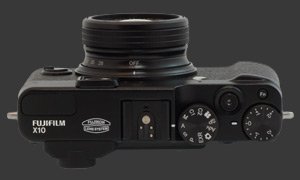
The top plate is split in two levels by a curve. The high side, towards the left, has the hot-shoe and built-in popup flash. The lower side, has a traditional mode-dial, threaded shutter-release, programmable function button and exposure compensation dial. The shutter-release has a good amount of travel to the half-point and triggers immediately below. Its position is not very comfortable, particularly because the necks trap eyelet can dig into your finder while taking a shot.
The exposure-compensation dial is marked ±2 in 1/3 EV increments. This makes exposure compensation easily accessible from the back of the camera. The dial has excellent detents to prevent accidental changes. This modal interface is not everyone's favorite but makes it obvious when EC is in effect. A small customizable button labelled Fn sits in front of the EC dial. There are 9 options to choose from for the Fn button but, since the X10 does not provide a direct button for changing ISO, this will be its most likely function.
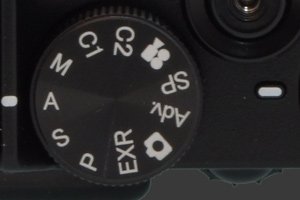 The mode-dial has 11 positions with good detents. The traditional PASM modes are all there and work with the sensor in EXR-HR mode which defaults to 12 megapixels output. Resolution can be reduced to 6 or 3 megapixels, in which case the Fuji X10 may switch to EXR-SN mode under certain conditions. There are also two custom modes which can be set to any EXR or PASM mode.
The mode-dial has 11 positions with good detents. The traditional PASM modes are all there and work with the sensor in EXR-HR mode which defaults to 12 megapixels output. Resolution can be reduced to 6 or 3 megapixels, in which case the Fuji X10 may switch to EXR-SN mode under certain conditions. There are also two custom modes which can be set to any EXR or PASM mode.
The EXR position on the mode-dial regroups all EXR modes under one. A menu options then selects between Auto-EXR, EXR-HR, EXR-SN and EXR-DR. It is really too bad they are bunched up together like this because it takes longer to set the desired one. There is a highly complex set of interaction between each mode and other camera settings such as ISO and Dynamic-Range, so the camera informs when it has to change a setting in response to a mode change. It also goes a great job at restoring the original setting when undoing mode changes.
There is a completely Automatic mode, labeled by a camera icon, which disables most settings and ignores the EC dial. Still, Film Simulation and the maximum automatically selected ISO can be set between 400 and 3200. The Adv position groups together the Advanced modes discussed on the previous page of this review. The SP position groups all Scene modes for those intimidated by manual controls.
The last position on the mode-dial is for recording video. This lets the camera always show the correct framing before filming. Entering video mode causes the camera menu to change and show options which are relevant to video. Most importantly, video resolution can be set up to full 1080p HD at 30 FPS. There are also a number of odd high-speed modes: 640x480 @ 70 FPS, 320x240 @ 120 FPS and 320x112 @ 200 FPS.
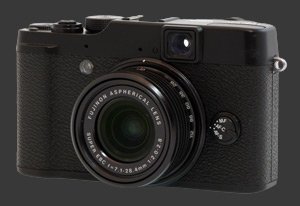
The front of the camera hosts the only remaining control which is not at the back. This is a rotating lever to toggle between AF-S, AF-C and MF focus modes. In Manual Focus mode, the rear control-dial sets the focus distance. The camera not only shows which distance is in perfect focus but also the depth-of-field around it.
The back of the camera has a 2.8" LCD with 460K pixels. The view is sharp and motion is fluid. Visibility is good but the screen aggressively dims down to save power. Just tap the shutter-release to brighten the LCD again. The biggest complaint about this camera is the poor accuracy of the display. The LCD is not Exposure-Priority and the optional Live-Histogram is based on the display brightness, making it useless most of the time. There is also a problem previewing white-balance. At least frame coverage of the LCD is accurate. Contrarily to the LCD, the optical tunnel viewfinder only shows 85% coverage, putting it in useless territory. Not only that, pulling a screw-up from Canon, the lens obstructs the view when the zoom is between 28 and 50mm.
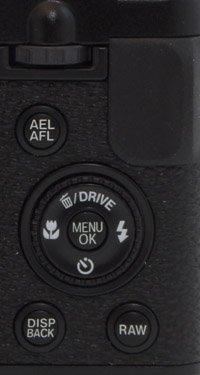 The back of the camera includes 2 controls dials, a 4-way controller and no less than 7 buttons. The upper control-dial is found right next to the thumb. It has soft detents and is actually clickable. Normally the upper control dial sets the main exposure parameter, such as the aperture in Aperture-Priority mode. In Manual mode however, clicking the upper control-dial toggles the parameter being changed. The other parameter then gets changed by the lower control-dial, except if focus is set to MF. In that case, the lower control-dial sets the focus distance.
The back of the camera includes 2 controls dials, a 4-way controller and no less than 7 buttons. The upper control-dial is found right next to the thumb. It has soft detents and is actually clickable. Normally the upper control dial sets the main exposure parameter, such as the aperture in Aperture-Priority mode. In Manual mode however, clicking the upper control-dial toggles the parameter being changed. The other parameter then gets changed by the lower control-dial, except if focus is set to MF. In that case, the lower control-dial sets the focus distance.
The lower control-dial is located around the 4-way controller. It is rather slim and moves freely, so it is a good thing that it is not used most of the time. With detents, Fuji could have added ISO control on that dial to free the Fn button. About of the 4-way controller, each direction is assigned a function:
- UP: Sets the drive mode. There are 7 drive modes to choose from: Single Shot, Continuous, Best Shot, AEB, ISO Bracket, Dynamic-Range Bracket and Film Simulation Bracket.
- RIGHT: Selects the flash mode between Auto, On and Slow-Sync. These only apply with the flash raised, otherwise it simply stays off.
- DOWN: Sets the self-timer between Off, 2s and 10s. It is fantastic that Fuji is finally not resetting the timer after each use. We have been complaining about it in each review until now.
- LEFT: Sets the macro mode to Off, Macro or Super-Macro. This last one can focus down to 1cm but only with the lens at its widest.
Above the 4-way controller is the customizable AE-L/AF-L button. It can be set to hold or toggle and can lock exposure, focus or both. Below the 4-way controller are the DISP and RAW buttons. The DISP button cycles through various display modes, one of which can be customized to include the single-axis digital level. The RAW button temporarily changes the file format between JPEG images and RAW files. Since most people choose sides, it is really too bad this button cannot be customized to do some more frequently used function.
To the left of the LCD is a vertical column of 4 buttons: Play, AE, AF and WB. As usual, Play enters and exists Playback mode. One can also exist Playback mode with a tap of the shutter-release. AE brings up a menu to select the metering mode between Multi-Segment, Spot and Average. AF in Area Focus-Point selection mode lets the user choose any of the 49 AF areas. At the same time, turning the upper control-dial, selects one of 5 sizes for the AF area. WB, as expected, selects White-Balance.
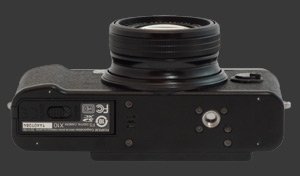 The bottom of the X10 has a metal tripod mount which is neither inline with the optical axis nor the center of the camera, meaning it is not ideal for anything. With a small tripod head though, it may be possible to change memory and batteries without removing the camera. Just like the top, the bottom is built to last. Even the plastic compartment door is more durable then usual.
The bottom of the X10 has a metal tripod mount which is neither inline with the optical axis nor the center of the camera, meaning it is not ideal for anything. With a small tripod head though, it may be possible to change memory and batteries without removing the camera. Just like the top, the bottom is built to last. Even the plastic compartment door is more durable then usual.
Overall, the Fuji Finepix X10 handles extremely well. Ergonomics are not perfect but the mechanical zoom is probably enough to excuse everything else. The lower dial can certainly be improved and the upper dial be made more useful since its clickable feature is only used in Manual mode. The most serious usability issue is the poor accuracy of the display which can be corrected via a firmware update. For now, this forces the photographer to review his images more often than desirable. The optical viewfinder not every useful, complex and takes up space. It would be immensely better if Fuji included the EVF component of the X100 instead.
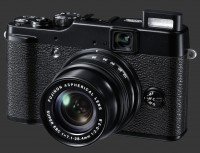 |
Please Support Neocamera
All information on Neocamera is provided free of charge yet running this website is a huge endeavor. Purchases made via affiliate links found throughout the site help keep it running and up-to-date. There is no additional cost to you, so please consider buying via these links to our affilates:
If you found any information on this site valuable and did not purchase via our affiliate links, please considering donating via PayPal:
Any amount will be greatly appreaciated. Thank you for your support!
Fujifilm X10 Highlights

Sensor-Size: 9 x 7mm

Actual size when viewed at 100 DPI
| 12 Megapixels Fixed Lens | ISO 100-3200 |
| 4X Mechanically Linked Wide Optical Zoom | Shutter 1/4000-30s |
| Built-in Stabilization | Full manual controls, including Manual Focus |
| 1 Axis Digital Level | Custom white-balance |
| 7 FPS Drive, 8 Images | Spot-Metering |
| 1920x1080 @ 30 FPS Video Recording | Hot-Shoe |
| 2.8" LCD 460K Pixels | Lithium-Ion Battery |
| Secure Digital Extended Capacity |
Updates
2024.04.03

Fujifilm X-T5 Review
Newest Fujifilm flagship boasting a 40 MP APS-C sensor, 5-axis IBIS with 7-stop efficiency, 15 FPS continuous drive, 6.2K Video capture, dual control-dials and dual SDXC UHS-II slots in a sturdy weatherproof and freezeproof body.
2023.11.20

Best Digital Cameras of 2023
Find out which are the Best Digital Cameras of 2023. All the new Mirrorless Digital Cameras from entry-level to high-end professional.
2023.07.10

Fujifilm X-H2 Review
40 Megapixels APS-C Hybrid Mirrorless Digital Camera with 7-stop IBIS. Fastest shutter ever and 8K video capture. Large builtin EVF with 0.8X magnification and 5.8 MP, plus an Eye-Start Sensor. Packed with features and large number of controls in a weatherproof and freezeproof body.
2023.05.07

Sony FE 20-70mm F/4G Review
Review of the unique Sony FE 20-70mm F/4G lens. The optical zoom of this lens spans ultra-wide-angle and medium focal-length coverage, making it one of the most versatile Full-Frame lenses on the market.
2023.01.15

Huion Inspiroy Dial 2 Review
Review of the Huion Inspiroy Dial 2 tablet, a medium sized drawing surface with dual dials and customizable buttons. Connects via USB-C or Bluetooth 5.0 with Windows, Linux and Android support.
2022.12.08

How to Pack for a Photo Trip
Find out how to pack for a travel photography trip, carry your gear safely while meeting airline regulations.
2022.11.13

Best Digital Cameras of 2022
The best digital cameras of 2022. A short list of the most outstanding models in their respective categories. Choose one for yourself or as a gift.
2022.09.21

Pentax DA* 60-250mm F/4 SDM Review
Review of the Pentax DA* 60-250mm F/4 SDM, the constant-aperture telephoto zoom with the highest zoom-ratio on the market.
2022.09.20

Pentax DA* 50-135mm F/2.8 SDM Review
Review of the Pentax DA* 50-135mm F/2.8 SDM, the lightest professional telephoto zoom native to the K-mount.
2022.09.10

Pentax DA* 11-18mm F/2.8 DC AW Review
Review of the Pentax DA* 11-18mm F/2.8 DC AW, the widest professional ultra-wide zoom native to the K-mount.
2021.11.24

50 Gifts Under $50 For Photographers in 2021
50 Gifts photographers will love. All for under $50 USD. 2021 Edition.
2021.11.17

Best Digital Cameras for 2021
Neocamera shows which are the very best Digital Cameras for 2021 in every category: Mirrorless, DSLR, Premium Compact, Ultra-Zoom and Rugged.












